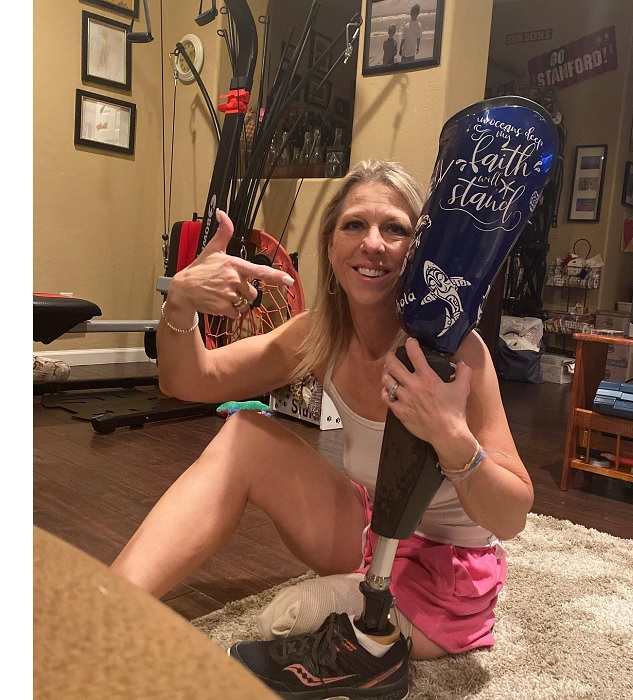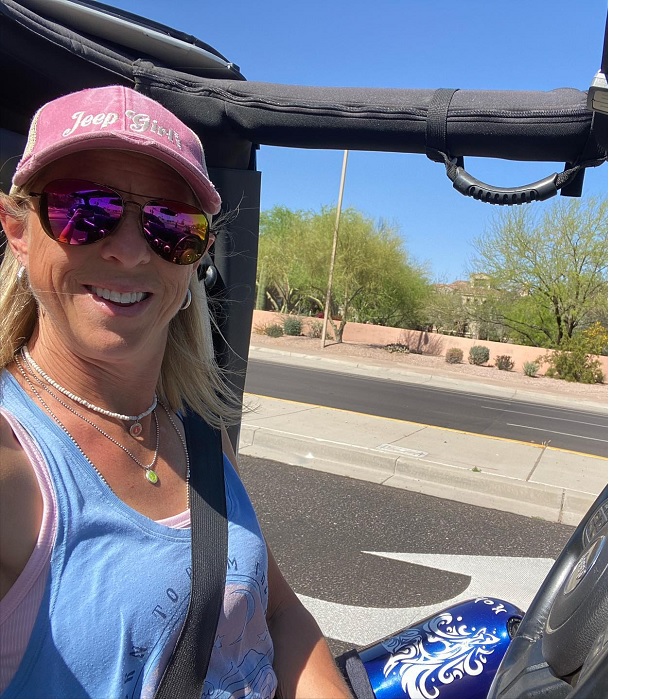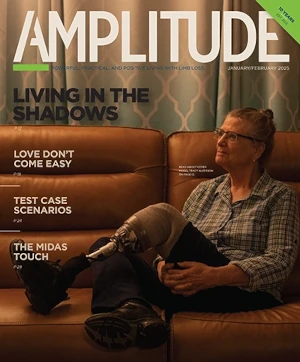by Angie Heuser
“You will never walk again.”
That’s what I was told by a medical professional, a surgeon whom I knew and trusted. He didn’t explain the reasons behind his opinion or waver from it. He just said he wouldn’t amputate the leg that had caused me so many years of pain and heartache, and that if I were to go through with the procedure, I’d never walk again. He didn’t discuss any different scenarios or offer any alternative solutions. He simply insisted that I was better off staying right where I was.

at bawarrior360.com
Here’s where I was at that moment. I had been through six years of surgeries with multiple doctors. I couldn’t straighten my leg, and I couldn’t bend it either. I was constantly on pain meds, and I had just come back from an overseas trip with a blood clot that started in my calf and traveled up to my knee. I wasn’t living my life, I was just surviving. This could not be better than the alternative.
I was crushed by this man’s comments, but I also didn’t accept them. “I’m sorry,” I said, as I struggled to keep it together. “Is that your professional opinion or a challenge?” It was hard to push back against an expert with so many years of experience and such an air of authority. “I’m sure you’ll prove me wrong,” he answered. As I left his office, tears welled up in my eyes. But I also felt strong, almost defiant. I was more sure of myself than ever.
Advocating for yourself is so very important. You know your body better than anyone. You know your grit, attitude, and strengths better than any medical professional. So when you are facing difficult decisions about your future, you have to be prepared to stand your ground in conversations with your doctor, especially when it comes to a huge decision like amputation.
It took me years to learn that lesson. When my leg first started to give me trouble in 2013, I accepted my surgeon’s word in every situation. Whatever he said, I took it at face value and moved forward with whatever he told me was the next step. I thought this passive approach gave me the best chance to heal, and that my own best interest lay in following my doctors’ orders and having faith the process.
But as time went on and my situation didn’t improve, I stopped being satisfied with that formula. I was being told nothing more could be done to improve the situation. That’s when I realized I’d have to take a far more active role in managing my case. I started looking over the post-operative notes from my doctors. I Googled terms I was unfamiliar with and jotted down my own notes. I talked with my physical therapist about my condition, and I started going to other doctors for second, third, and fourth opinions. Some turned me away, not wanting to get involved in my medical mess. Others gave me the same opinion, “Nothing else can be done.” Still others suggested that more surgery might solve the problem.
I ended up seeing a dozen different doctors and tried all kinds of different treatments, but I couldn’t find any relief from my ailments. I was tired, in pain, and sick of missing out on life. After many unsuccessful surgeries, I noticed a comment in one post-operative report that talked about “arthrofibrosis.” It was the first time I had seen that particular term before. When I Googled it, I discovered it describes a fairly common phenomenon: hyperscarring in joints after invasive surgery. Arthofibrosis stiffens the joint, limits its range of motion, and causes tremendous pain—the exact set of symptoms that were making my life miserable.

Why hadn’t any doctor talked to me about this at any point over the previous six years? I was angry and frustrated. When I shared this discovery with my physical therapist, he pointed out that not only is arthrofibrosis common, it could explain why each of my surgeries eventually failed. Every operation made the scarring worse and intensified the problem, rather than offering relief. Yet not a single doctor had discussed this possibility with me before moving forward with a new procedure. Nobody warned me that surgery might be part of the problem, rather than the solution. I had to figure that out on my own.
Now that I’d actually identified the culprit causing my problem, I felt I was more educated about my knee than my surgeons. I needed to work this out in my head and move beyond my old “doctor knows best” attitudes. I’m grateful I had a PT who was totally invested in me. In every session, we would talk about different options, scenarios, and specialists who might be able to help. I needed doctors who could think outside the box, and who would respect my opinions and communicate with me as an equal.
Advocating for yourself in a medical appointment isn’t easy. We expect the doctor to have all the knowledge necessary to help us, but they don’t always have all the answers. They don’t always know how to help. Sometimes they’re even dead-set against the one thing that might actually improve your condition.
After I left the surgeon’s office, with his opinion that “you’ll never walk again” ringing in my ears, I felt more certain than ever that removing my leg was the right thing to do. I had done my research. I’d discussed it with my family. I had even talked it over with prosthetists, so I would know what to expect in the aftermath of limb loss.
I called the prosthetist I intended to work with, someone who is an amputee and a very active person. I made an appointment with the doctor who eventually performed my amputation. I discussed my feelings and concerns, and I asked more questions so I could get a clear picture of my future as an amputee.
Here’s what the future has turned into. Two and a half years after having my leg amputated above the knee, I hike regularly. I’ve run a 10K. I’ve learned to surf. I’m off pain medications. I’m enjoying all the things I dreamed of doing when my doctors were telling me there was nothing left to be done.
And yes, I am walking again. I did prove my surgeon wrong, because I trusted myself more than I trusted him. That’s the first step in advocating for yourself.
Angie Heuser has been an above-knee amputee since 2019. She features amputee advice, interviews, news, and personal reflections through her blog and podcast at bawarrior360.com. Follow her on Instagram @angie_heuser.
MORE ARTICLES BY ANGIE HEUSER:
“First Person: Amputee Surfing”
“First Person: My First 10K as an Amputee”
“First Person: Restoring a Sense of Balance”
“First Person: Amputee Hiking, One Step at a Time”



